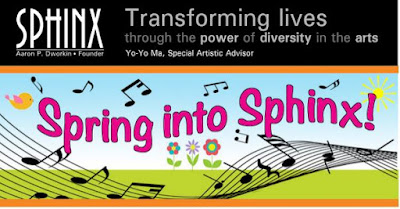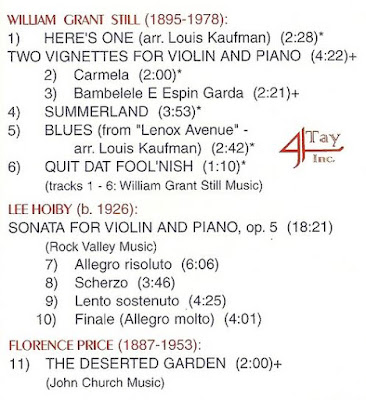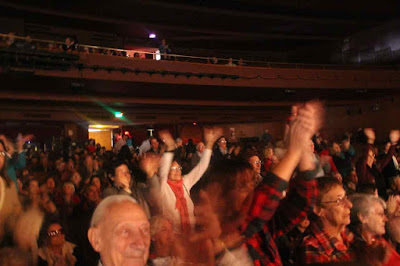The Here's One CD and a variety of related scores are available at:
http://www.williamgrantstill.com/s?defaultSearchTextValue=Search&searchKeywords=Here%27s+One&Action=submit
This recording is named for the first track, Here's One (2:28), arranged by violinist Louis Kaufman. Next on the program are Two Vignettes for Violin and Piano (4:22). They are Carmela (2:00) and Bambelele E Espin Garda (2:21). The fourth track is Summerland (3:53). The fifth track is Blues (2:42) (from "Lenox Avenue" and also arranged by Louis Kaufman). The sixth and final track of William Grant Still is Quit Dat Fool'nish (1:10). Lee Hoiby's composition on the disc is his Sonata for Violin and Piano, Op. 5. Florence Price's contribution to the recording is The Deserted Garden (2:00).
In addition to the works of William Grant Still, Lee Hoiby and Florence Price listed above, this CD includes Henry Cowell's Sonata for Violin and Piano (16:42), and Aaron Copland's Two Pieces for Violin and Piano (9:17) and Hoe-Down (from Rodeo) (2:51).
On May 12, 2015 violinist Zina Schiff sent us an email at the suggestion of Judith Anne Still. Here is an excerpt:
Dear Judith Anne's friend Bill,
I am so pleased to "meet" you !!
When
I was a little girl, growing up in Los Angeles, there was a man who
often attended the Meremblum Jr. Symphony rehearsals and concerts, where
I played. You could tell he loved children and music, but he
was so gorgeous, I thought he was a movie star, like many of Mr.
Meremblum's friends.
In 1994, I had the
great pleasure of recording 6 violin works by William Grant Still on an American
album called "Here's One", and it was then, that I realized that he was
my movie star!! (Florence Price's The Deserted Garden is on the cd, too).
Zina Schiff offered to send a copy of the CD, and asked for a mailing address. We quickly accepted the offer, and the violinist wrote again:
Will pop the cd into the mail today. Also I am including a review
of it I recently received, from Australia - `they are only now discovering
it, after all these years! Both Still and Price are singled out, which
made me happy.
Zina Schiff included this note with the CD:
May 2015 "Here's One" especially for Bill Zick - a belated birthday celebration of William Grant Still's birthday - and appreciation for what you do to keep him alive! - Zina
Here’s One is 4TAY-CD-4005, a 1997 release of 4-TAY, Inc. The performers are Zina Schiff, violin, and Cameron Grant, piano. The liner notes are by Dana Paul Perna. He begins:
“American composers have produced a unique repertoire for the violin - as varied as the States which form her Union, or the stars and stripes on her Flag. The composers heard on this collection are relatively contemporary with one another; the centennial year of William Grant Still’s birth and Aaron Copland’s 95th birthday year occurred in 1995, Lee Hoiby’s 70th birthday year was observed in 1996, and, 1997 marks the centennial of Henry Cowell’s birth as well as the 110th birthday year of Florence Price.
"The first instrument William Grant Still (1895-1978) studied as a child was the violin. While he bears the distinction of being the 'Dean of Black American Composers', the selections heard on this collection reflect his interest n the music of various cultures.
"When Still moved to Los Angeles in 1934, he made the acquaintance of the renowned violinist Louis Kaufman, who became an ardent champion and friend of the composer. Late in his career, Kaufman recorded an all-still album that included some of his arrangements which Still authorized and included as part of his catalogue. Here's One, the title selection on this recording, is one of those arrangements which was prepared from Still's original setting of this Negro spiritual for voice and piano. The South American tunes, CARMELA and BAMBELELE E ESPIN GARDA, serve as the melodies for Still's TWO VIGNETTES."
"Originally composed for piano as the second movement of his 'Three Visions', SUMMERLAND depicts the 'heaven' to which the soul journeys at life's end and is heard here in Still's own transcription. BLUES derives from Still's radio music-drama 'Lenox Avenue' in an arrangement by Louis Kaufman, who often performed it as an encore. Still dedicated QUIT DAT FOOL'NISH to his 'mischievous' dog, Shep. Originally a piano solo, the violin and piano version was prepared by the composer."
FLORENCE SMITH PRICE (1887-1953) was America's first Black female composer of serious music to achieve recognition. In 1932, her reputation grew when she was awarded the Wanamaker Prize for both her 'Piano Sonata' and 'Symphony in E Minor.'
"Very little (if anything) is known about THE DESERTED GARDEN. Price's biographer, Dr. Rae Linda Brown, believes it to be one of a number of 'teaching pieces' she composed for young violin students. While its form, harmonic content and technical demands are meant to be not too challenging for the developing musician, it is not uncharacteristic of Price's other more demanding music intended for mature players."
Stringendo, Journal of the Australian Strings Association, Volume 36, Number 2, October 2014.
Here's One
Zina Schiff, violin, Cameron Grant, piano
4Tay CD 4005
"Here's One is violinist Louis Kaufman's arrangement of William Grant Still's setting of a Negro spiritual for voice and piano. Blues is also a very effective Kaufman arrangement of the same composer's work. Indeed the opening six pieces are Still's original compositions, very stylishly played by Zina Schiff. Sonata by Lee Hoiby (1950 rev. 1979) and Henry Cowell follow. Hoiby employs a unique and elegant 20th century lyricism. Cowell's excellent Sonata of 1945 was dedicated to Joseph Szigeti and exhibits modal treatment and contrapuntal technique. In the Finale the composer employs 'stopped' piano strings. Florence Price, the first African-American female composer of serious music to achieve recognition, is represented by a lovely vignette, The Deserted Garden. The CD is rounded out by Aaron Copland's Nocturne, Ukelele Serenade and Hoe-Down.
"This is an excellent introduction to a varied selection of American violin and piano music beautifully interpreted by Zina Schiff and her associate artist Cameron Grant."
Naxos.com begins its bio of Zina Schiff this way: "The award-winning American violinist Zina Schiff is a Heifetz protégée. She has made acclaimed appearances throughout North America, Eastern
and Western Europe, Israel, Australia, and New Zealand. In the United
States she has appeared as a soloist with such orchestras as
Philadelphia, Baltimore, Washington, Rochester, Brooklyn, San Antonio,
Nashville, San Diego, Los Angeles, San Francisco, and Seattle."
The notable American violinist Zina Schiff and the pianist Cameron Grant bring us a welcome program of 20th century music by five American composers born between 1887 and 1926.
Most of the works of William Grant Still were pleasantly familiar to us, but the title track, Here's One, was an enjoyable new find. The disc also introduced us to The Deserted Garden of Florence B. Price, which was another welcome discovery. We are also happy to be introduced to the Sonatas for Violin and Piano of Lee Hoiby and Henry Cowell, and to the Two Pieces for Violin and Piano of Aaron Copland. This recording was first released in 1997, but it has stood the test of time and is still available. Many CDs of William Grant Still have recently been reissued, often by ArkivMusic.com. We sincerely hope this CD will also be reissued, to assure its continued availability indefinitely. We have listened to the recording many times, and fully expect to continue to hear it often.
Disclosure: A review copy of this recording was provided by the violinist.
Comments by email:
1) During the Free FREEDOM CONCERT to celebrate the 150th anniversary
END of CIVIL WAR & 13th Amendment ABOLISH SLAVERY on May 24, 2015 at
Hall of Liberty-Hollywood Hills Forest Lawn, Violinist Annelle Gregory
and Pianist Mary Au opened a three song set with Here's One followed by
Summerland composed by William Grant Still. We anticipate posting the
performance in the future. Thanks, John Malveaux
2) Dear Bill, What timing !! I just
spoke with Dana Paul Perna, who called to wish me good luck on my
upcoming journey . Tomorrow, God-willing I will be en route to Prague, to
record the William Grant Still Pastorela,with Avlana conducting. Thank you so very much for your kind words and for telling folks about the cd. Your grateful new friend, Zina [Zina Schiff]
3) Bill, this is a spectacular compendium of all that is remarkable about Still, Price, Schiff, and the best in music. Wonderful reviews and
comments. [Judith Anne Still]






































